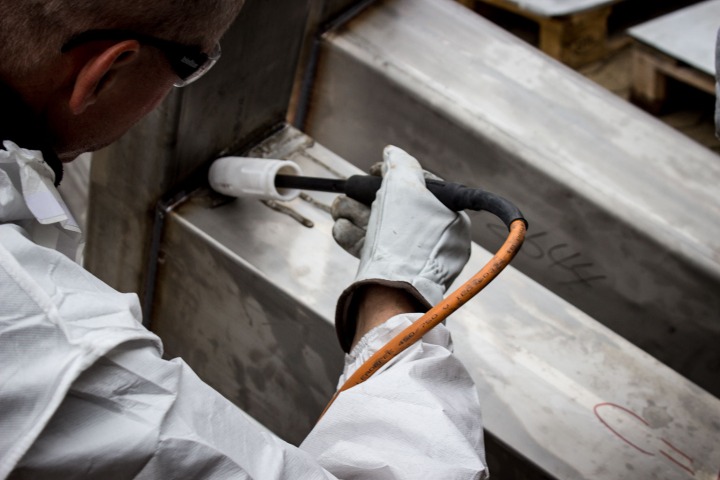What is the difference between carbon fiber brush and felt pad weld cleaning?
Weld cleaning | Friday, 05 August 2022
Successful weld cleaning is all about using the best equipment. Electrochemical weld cleaning is mostly done with carbon fiber brushes, but how come felt pad cleaning is no longer seen as an effective method?
How effective is weld cleaning with a felt pad compared to a carbon fiber brush? In this article, we’ll compare the two methods and review the pros and cons.
What is felt pad weld cleaning?
Weld cleaning with felt pads is done with an electrochemical weld cleaning machine. Instead of using a carbon fiber brush to clean the work surface, you use a felt pad placed over a carbon block or metal tab dipped in weld cleaning fluid. It works the same way as cleaning with a brush, but there are several reasons why the felt pad method is outdated.
While the felt pad may work fine for weld cleaning on plain or smooth surfaces, it’s not at all optimal for bumpy surfaces or corners. Using a solid block covered with felt it’s nearly impossible to get into some internal corners, therefore, leaving some critical parts of the workpiece not passivated.
It’s hard to see when the felt pads wear through, but when they unexpectedly wear down too much the carbon block arcs directly with the workpiece giving an unsightly black spot on your workpiece. Furthermore, the felt works at low temperatures (up to 200*C) so cleaning is slower than when using a carbon fiber brush.
As a result of these disadvantages, the weld cleaning industry has evolved and now most manufacturers only offer carbon fiber brushes.
What is a carbon fiber brush?
Carbon fiber brushes are attached to the handle of a weld cleaning machine. The brush is then dipped in weld cleaning fluid (or pumped to the brush using automatic fluid feed) and applied to the weld seam to be cleaned.
The brushes are made of millions of individual carbon fibers which is a very strong and lightweight material. The carbon fibers are held tightly together with a copper crimp or a stainless steel crimp. The copper crimp provides excellent electrical conductivity giving reduced power loss during cleaning. If you are manufacturing stainless steel for industries where cross-contamination is an absolute no-go you can get brushes with a stainless steel crimp, thus eliminating the risk of cross-contamination.

The advantages of using a carbon fiber brush are many. The brush is very flexible and can easily get into corners and works perfectly for uneven surfaces. The carbon fiber brushes also work at higher temperatures (around 300 *C) meaning faster and more effective cleaning, even on heavily oxidized welds. We have different brush options for different machines and different designs depending on your item. Read our guide on weld cleaning brushes here.
How long does a carbon fiber brush last?
Generally, we say that our carbon fiber brushes last anywhere between 7-12 hours of constant weld cleaning. The variation allows for different power settings on the machine and different weld cleaning applications. But very few of us weld clean for 7+ straight hours without stopping, so we, therefore, recommend maintaining your brushes regularly. This includes:
- Cleaning the brush after use with water to remove excess fluid before putting the machine into storage.
- Use a protective shroud and ensure it is positioned properly at all times during use. This ensures the full length of the fibers is used and helps to hold the fibers in place to ensure concentration of power and heat for more effective cleaning.
Replace parts if they are damaged. For example, if the shroud is damaged you should replace it immediately – this will prolong the life of your brush and ensure the metal crimp does not arc by mistake on your workpiece.
What carbon fiber brush should I use?
It all depends on your workpiece and what machine you are weld cleaning with. If you are weld cleaning with a Cougartron weld cleaning machine under 80 amps, our Superbrush is right for you. If your weld cleaner goes over 100 amps, you have the FURY 200A brush at your disposal.
In addition, we have dedicated brushes for specific production challenges, including our Thunderbrush and Pipebrush (both used at under 80 amps power output.). See our selection here.
How do I know what size of brush I need?
Again, it depends on what item you are weld cleaning. We have handles with adaptors for one brush and handles with adaptors to hold four brushes simultaneously. Using four brushes at the same time gives you a much bigger contact area where you are cleaning, meaning more efficiency in some applications.
Typically, you would use one brush for tight corners or narrow weld seams (for example single or double pass TIG welds). On the other hand, you would use three or four brushes for wide weld seams (double pass MIG welds) and applications where a higher current is needed – for example heavily oxidized welds.
If you need advice on choosing the right carbon fiber brush, please do not hesitate to contact us.
Contact us
Loading...
Please wait while the form loads.


 English
English  English (US)
English (US)  German
German  Danish
Danish  Swedish
Swedish  French
French  Polish
Polish  Spanish
Spanish